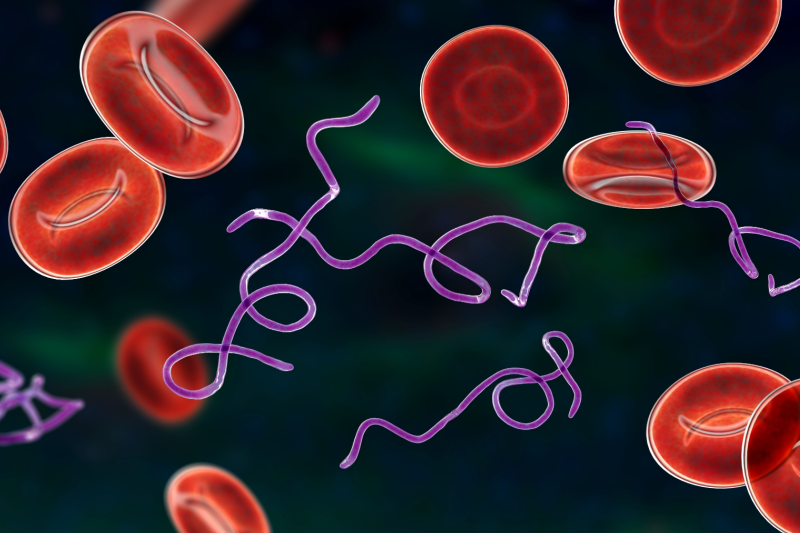Exploring the Link Between Lyme Disease and Autoimmune Disorders
Lyme disease, a tickborne illness caused by the bacterium Borrelia burgdorferi, is notoriously difficult to diagnose and treat.
The ailment is the most commonly transmitted tickborne infection in the United States and among the most frequently diagnosed worldwide.
At the same time, autoimmune diseases, which arise when the immune system mistakenly attacks the body's own tissues, are also an ongoing concern.
Studies show a notable increase in antinuclear antibodies (ANA), the most common biomarker of autoimmunity, over the past 25 years in the United States.
While these two conditions may seem unrelated, there is a significant overlap between Lyme disease and autoimmune disorders, both through their symptoms and pathologies.
Understanding this interplay is crucial, as co-occurrence can lead to increased symptom severity and complicate treatment strategies.
In this blog, we'll navigate the complex relationship between Lyme and autoimmune diseases, including the pathophysiological interactions, potential complications, and advanced diagnostic tools to combat these illnesses. 
Table of Contents
Overview of Lyme and Autoimmune Diseases

Lyme disease is a vector-borne illness primarily transmitted to humans through the bite of infected black-legged ticks.
The disease is caused by the bacterium Borrelia burgdorferi and, less commonly, by Borrelia mayonii.
Initial symptoms of Lyme disease often include fever, headache, fatigue, and the characteristic skin rash erythema migrans, also known as the “bullseye” rash.1
If left untreated, the infection can spread to the joints, heart, and nervous system, leading to more severe and chronic health problems.
Early diagnosis and treatment with antibiotics are critical to prevent disease progression.
However, the early symptoms of Lyme disease can be nonspecific and easily mistaken for other illnesses, complicating the diagnostic process.
Autoimmune Diseases

Autoimmune diseases occur when the immune system, which typically protects the body from infections and diseases, mistakenly attacks healthy tissues.
They affect 3–5% of the population, with autoimmune thyroid disease and type I diabetes being the most common.
These diseases can affect various parts of the body, including joints, skin, brain, and other organs.
The exact cause of autoimmune diseases remains unknown, but experts believe they result from a combination of genetic, environmental, and hormonal factors.
Symptoms can vary widely depending on the specific disease and the organs affected, making these conditions challenging to diagnose and manage.
Autoimmune diseases often require lifelong treatment to manage symptoms and prevent flare-ups.
Prevalence & Impact

Both Lyme disease and autoimmune diseases are significant public health concerns due to their increasing prevalence and potential for severe, long-term impacts on patient health.
Lyme disease has been on the rise over the past few decades, with tick populations and the diseases they carry more than doubling in the past 13 years.
Autoimmune diseases collectively affect millions of people worldwide, with women being disproportionately affected.
Co-occurrence of these conditions can lead to complex clinical presentations, requiring a nuanced approach to diagnosis and treatment.
Pathophysiological Interactions
Through various pathways, Lyme disease can lead to the development of autoimmune conditions.
Triggering Autoimmune Responses

Lyme disease can play a significant role in triggering or exacerbating autoimmune responses.
One of the primary mechanisms behind this interaction is molecular mimicry.
Molecular mimicry occurs when the immune system confuses antigens with the body’s own tissues due to structural similarities.
This misidentification can lead to an autoimmune response, where the immune system attacks healthy tissues, mistaking them for the invading pathogen.
Autoimmune complications of Lyme disease include Lyme arthritis, carditis, and neuroborreliosis.
Immune System Dysregulation

The chronic immune stimulation caused by persistent Borrelia infection can lead to dysregulation of the immune system.
In some cases, Lyme disease can shift the immune response from a primarily defensive role to one that is overly aggressive and self-targeting.
This dysregulation can manifest in various autoimmune diseases, such as rheumatoid arthritis, lupus, and autoimmune thyroiditis.
One example is Lyme arthritis, characterized by an excessive, dysregulated pro-inflammatory immune response during the infection phase that persists even after the infection is gone.
This response involves high amounts of IFNγ, a cytokine that typically aids in fighting infections, and inadequate amounts of the anti-inflammatory cytokine IL-10.2
This causes impaired tissue repair, vascular damage, autoimmune and cytotoxic processes, and fibroblast proliferation and fibrosis.
These synovial characteristics are similar to those in other chronic inflammatory forms of arthritis, including rheumatoid arthritis.
Additionally, in these conditions, the chronic inflammation and immune response may not subside even after the infection is controlled, leading to ongoing autoimmune activity, as seen in chronic Lyme disease.
Patients with compromised immune systems due to Lyme disease and autoimmune diseases are at higher risk for other infections.
The immune dysregulation caused by these conditions can make patients more susceptible to opportunistic infections, which can further complicate their health status and treatment plans.
Cross Reactivity
Cross-reactivity is another mechanism through which Lyme disease can influence autoimmune conditions.
Antibodies produced in response to Borrelia burgdorferi infection may cross-react with host tissues that share similar antigenic determinants.
This cross-reactivity can contribute to the development or exacerbation of autoimmune diseases.
For instance, antibodies targeting Borrelia proteins may also bind to proteins in the joints, nervous system, or other organs, leading to autoimmune damage.
Chronic Inflammation

Persistent Borrelia infection can cause chronic inflammation, which plays a critical role in the pathogenesis of autoimmune diseases.
Chronic inflammation can damage tissues and organs, creating a cycle of immune activation and tissue destruction.
This persistent inflammatory state can lower the threshold for developing autoimmune diseases in genetically predisposed individuals.
Furthermore, chronic inflammation can exacerbate existing autoimmune conditions, making their management more challenging.
Immune System Exhaustion
The immune system's prolonged battle against Lyme disease can lead to immune exhaustion, where immune cells become less effective at responding to infections and controlling inflammation.
This state of exhaustion can leave patients more vulnerable to other infections and impair the regulation of autoimmune responses.
Thus, long-term exposure of the host’s immune system to spirochetes, the bacteria responsible for Lyme, can contribute to the new development of chronic autoimmune diseases.
Interaction of this bacterium with the host can cause inflammatory, immunomodulatory, and immunosuppressive effects.
Through molecular mimicry, among other mechanisms, patients can develop antibiotic-resistant Lyme disease and subsequent autoimmune reactions and diseases.3

Further, infection can transform the preclinical phase of an autoimmune disease into an active one.3
In the preclinical stages, autoantibodies may be present for years prior to the development of overt systemic disease.
Many infectious agents can act as triggers for the initiation and expression of autoimmune diseases.
In addition to antigen-specific activation of lymphocytes, microbes can provide a secondary signal required to induce a pathogenic autoimmune response, referred to as the adjuvant effect of infection.
Thus, infection from Borrelia Burgdorferi may trigger an autoimmune disease already in motion to manifest in the body fully.
Finally, immune exhaustion can also hinder the effectiveness of treatments aimed at modulating the immune system, complicating the management of both Lyme and autoimmune diseases.
Genetic Predisposition

Individuals with a genetic predisposition to autoimmune diseases may be more susceptible to developing these conditions following Lyme disease infection.
Certain genetic factors can influence the likelihood of both contracting Lyme disease and developing autoimmune responses.
For instance, specific human leukocyte antigen genotypes have been associated with increased risk for autoimmune diseases and may also affect the immune response to Borrelia infection.
Genetic studies in adults with Lyme arthritis show a connection with MHC class II DR2 and DR4 molecules, which are essential for activating the immune system.3
These two molecules can be found on the surface of certain immune cells, and their job is to present antigens to helper T cells.
Differences in the genes that code for these molecules affect the immune system in two ways: they influence which peptides bind to MHC class II and how T-cells are selected in the thymus.
So, while Borrelia antigens are presented to T cells in all individuals, genetic polymorphisms can modify the efficiency and effectiveness of this process, potentially affecting the immune response in people with these genetic variations.
Understanding these pathophysiological interactions is crucial in diagnosing and managing patients with both Lyme disease and autoimmune diseases.
Complications Arising from Co-Occurrence
The co-occurrence of Lyme disease and autoimmune diseases can lead to a range of complications that can significantly impact health and complicate treatment.
Increased Severity of Symptoms
When Lyme disease and autoimmune diseases occur together, patients often experience more severe symptoms than those with either condition alone.
The inflammatory response triggered by Borrelia infection can exacerbate the symptoms of autoimmune diseases, leading to increased pain, fatigue, and overall discomfort.
For example, patients with rheumatoid arthritis may find that their joint pain and swelling are more intense and persistent when they also have Lyme disease.
Diagnostic Challenges

Diagnosing Lyme disease in the presence of an autoimmune condition can be particularly challenging.
Both Lyme disease and autoimmune diseases present similar symptoms impacting the skin, joints, nervous system, and heart.3
This symptom overlap can lead to misdiagnosis or delayed diagnosis, complicating treatment.
Additionally, the immune response in autoimmune diseases can interfere with the accuracy of Lyme disease tests, making it harder to identify the infection.
Treatment Complications

Treating patients with both Lyme disease and autoimmune diseases is complex.
Standard treatments for Lyme disease typically involve antibiotics, which can affect the immune system and potentially worsen autoimmune symptoms.3
Conversely, treatments for autoimmune diseases often include immunosuppressive drugs, which can hinder the body's ability to fight Borrelia infection effectively.
This creates a delicate balance in treatment strategies, requiring careful management to avoid exacerbating either condition.
Chronic Inflammation & Tissue Damage
The persistent inflammation caused by both Lyme disease and autoimmune diseases can lead to significant tissue damage over time.
Chronic inflammation can harm joints, muscles, nerves, and organs, leading to long-term health issues and decreased quality of life.
For instance, patients with Lyme disease and lupus may experience a more rapid progression of kidney damage due to the compounded effects of inflammation from both conditions.
Identifying Lyme & Autoimmune Disease Through Advanced Diagnostics
Accurate diagnosis and effective treatment of patients with both Lyme and autoimmune diseases is essential for mitigating autoimmune progression and improving outcomes.
Early detection is crucial, as delayed diagnosis can worsen health outcomes.
You can utilize precision testing to identify Lyme and autoimmune diseases faster and more accurately.
Tickborne Diseases Test + Lyme Autoimmune Panel

The Tickborne Diseases Test uses an innovative customizable multiplex protein microarray and chemiluminescence technology to evaluate 121 analytes, capturing both antibody responses and direct pathogen DNA.
The panel detects a broad range of antibodies and exposure to multiple pathogens simultaneously, including Lyme disease and TBRF and coinfections of tickborne diseases like Anaplasma, Babesia, Borrelia, Bartonella, Ehrlichia, and Rickettsia species.
When compared with traditional testing methods, Vibrant’s technology provides several advantages, including:
- Optimization: Allows testing for many different antigens at the same time without sacrificing accuracy or sensitivity
- Automation: The automated process enhances efficiency
- Utilization of Resources: Reduces turnaround time and labor costs and removes the need for manual handling and subjective result interpretation
- Streamlined Process: Detects all antibodies in a single run
The test's microarray, structured in pillars with individual microchips, isolates each protein, preventing the cross-reactivity that plagues conventional blot tests.
This method not only identifies a broad range of infections but significantly increases the chances of early intervention by combining antibody (indirect) and DNA (direct) testing.
By catching Lyme disease and common coinfections early, you can create personalized treatment plans to mitigate the effects of the disease sooner, potentially preventing the development of complications and autoimmune diseases.
Lyme Autoimmune Panel

To specifically detect autoimmune conditions associated with Lyme disease, you can combine the Tickborne Diseases test with the Lyme Autoimmune panel.
The Lyme Autoimmune panel detects 15 antibodies against specific antigens related to Lyme disease that are known to trigger or mimic autoimmune conditions, focusing on arthritis, carditis, and neuroborreliosis.
By identifying specific autoantibodies, the test provides insights into the autoimmune mechanisms at play, aiding in the diagnosis of Lyme-related complications.
This test can detect autoimmune activity even before clinical symptoms become apparent, allowing for earlier intervention.
Finally, the panel offers a broad analysis of autoantibodies against neural, cardiac, and joint proteins, facilitating a holistic understanding of your condition.
Testing for Lyme-linked autoimmune responses is crucial for those currently diagnosed with Lyme disease or post-treatment to identify the presence of or risk for developing autoimmune conditions.
Understanding the root cause of symptoms is vital for receiving appropriate treatment and preventing further damage.
Balancing Disease Overlap to Achieve Longevity

The intersection of Lyme and autoimmune diseases presents a complex and challenging scenario in the human body.
Understanding the intricate pathophysiological interactions and potential complications arising from co-occurrence is crucial for optimal management.
Tools like the Tickborne Diseases Test, Lyme Autoimmune Panel, and Autoimmunity Zoomer are pivotal in identifying these conditions early and guiding tailored treatment strategies.
Early detection and regular monitoring are essential to managing these issues and mitigating the long-term impact on quality of life.
As the prevalence of Lyme disease and autoimmune diseases continues to rise, staying informed about the latest research and diagnostic innovations is imperative.
By adopting a comprehensive and proactive approach to testing and treatment, you can enhance patient outcomes and provide more effective, integrated care for those grappling with these complex conditions.
Want to learn more about tickborne diseases and autoimmunity?
Read these next:
The Link Between Tick Bites & Autoimmune Diseases: What You Need to Know
Beyond Lyme: Exploring Lesser Known Tickborne Coinfections
Misdiagnosis and Delayed Treatment: The Consequences of Chronic Lyme Disease
References:
- Skar GL, Simonsen KA. Lyme Disease. [Updated 2024 Jun 9]. In: StatPearls [Internet]. Treasure Island (FL): StatPearls Publishing; 2024 Jan-. Available from: https://www.ncbi.nlm.nih.gov/books/NBK431066/
- Lochhead, R.B., Strle, K., Arvikar, S.L. et al. Lyme arthritis: linking infection, inflammation and autoimmunity. Nat Rev Rheumatol 17, 449–461 (2021). https://doi.org/10.1038/s41584-021-00648-5
- Yehudina Y, Trypilka S. Lyme Borreliosis as a Trigger for Autoimmune Disease. Cureus. 2021 Oct 10;13(10):e18648. doi: 10.7759/cureus.18648. PMID: 34786243; PMCID: PMC8578812.
 By
By



